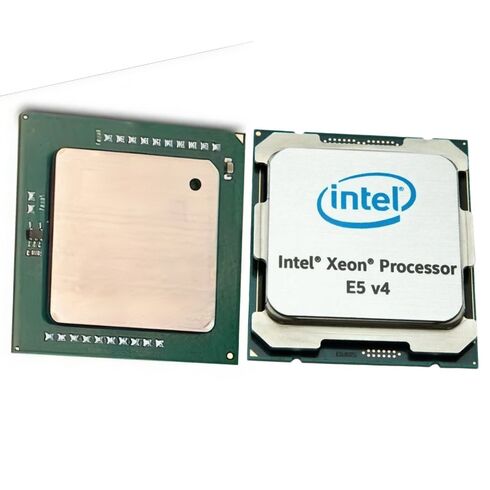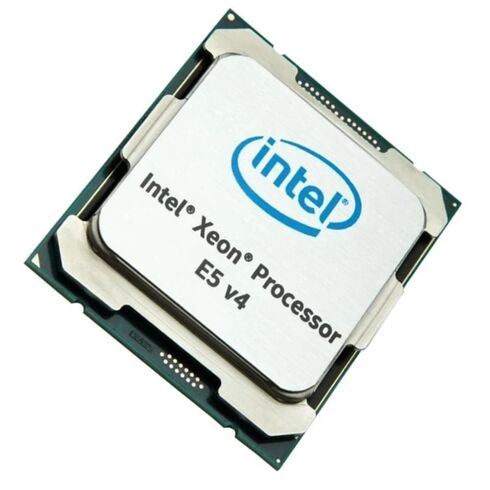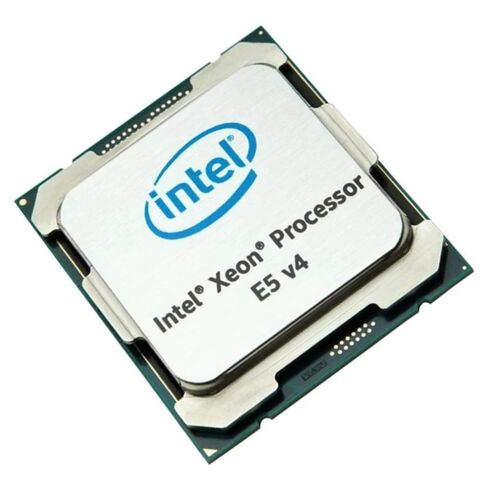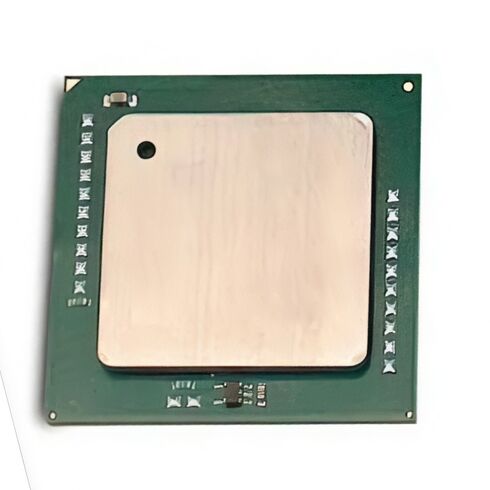801285-B21 HPE Intel Xeon E5-2640v4 10-Core 2.4 GHz Processor
- — Free Ground Shipping
- — Min. 6-month Replacement Warranty
- — Genuine/Authentic Products
- — Easy Return and Exchange
- — Different Payment Methods
- — Best Price
- — We Guarantee Price Matching
- — Tax-Exempt Facilities
- — 24/7 Live Chat, Phone Support
- — Visa, MasterCard, Discover, and Amex
- — JCB, Diners Club, UnionPay
- — PayPal, ACH/Bank Transfer (11% Off)
- — Apple Pay, Amazon Pay, Google Pay
- — Buy Now, Pay Later - Affirm, Afterpay
- — GOV/EDU/Institutions PO's Accepted
- — Invoices
- — Deliver Anywhere
- — Express Delivery in the USA and Worldwide
- — Ship to -APO -FPO
- — For USA - Free Ground Shipping
- — Worldwide - from $30
Product Overview
The HPE E5-2640v4 processor is a powerful server-grade solution designed to optimize your system’s performance. Engineered for high-efficiency and reliability, it serves as an excellent choice for a variety of server applications.
Manufacturer Details
- Brand: HPE
- Part Number: 801285-B21
- Processor Model: E5-2640v4
- Product Type: Server Processor
Core and Performance Features
- Core Configuration: 10 cores for enhanced multi-tasking
- Base Clock Speed: 2.4 GHz
- Max Turbo Frequency: 3.4 GHz for dynamic performance boost when needed
- QuickPath Interconnect (QPI) Speed: 8 GT/s for faster communication between cores
- Number of QPI Links: 2, offering more efficient data transfer
- Instruction Set: 64-bit architecture for superior processing capability
- Instruction Set Extensions: AVX 2.0 for improved floating-point performance
Cache and Efficiency
- L3 Cache: 25MB for enhanced data retrieval
- Fabrication Process: 14nm lithography ensures optimal efficiency and thermal management
- Thermal Design Power (TDP): 90W, providing a balance between performance and energy consumption
- Socket Compatibility: FCLGA2011 socket for seamless integration with compatible server boards
Processor Architecture and Technology
With its cutting-edge 14nm process technology, the HPE E5-2640v4 provides energy-efficient operation while maintaining high processing power. This architecture ensures the processor handles high loads while staying within thermal limits.
Key Features Summary
- 10-core processor for excellent multi-core performance
- Max Turbo Frequency of 3.4GHz ensures high-speed execution of demanding applications
- Efficient power usage with a TDP of just 90W
- Advanced AVX 2.0 instructions for faster data processing
- High capacity L3 Cache to reduce bottlenecks and speed up data retrieval
Compatibility & Installation
This server processor is compatible with FCLGA2011 socket, making it an ideal choice for a range of server and workstation builds. Whether you're upgrading an existing server or building a new one, the E5-2640v4 offers the performance and reliability you need.
Core Count
Introduction
The HPE Intel Xeon E5-2640v4 CPU & Processors are equipped with an impressive core count of 10. This feature plays a crucial role in determining the performance and capabilities of the processor. In this section, we will explore the benefits and importance of having 10 cores in this CPU.
Enhanced Multitasking
With 10 cores at their disposal, users can expect a significant boost in multitasking capabilities. Each core can handle individual tasks simultaneously, allowing for smoother and more efficient execution of multiple applications. Whether you're running resource-intensive software or engaging in heavy multitasking, the high core count ensures a seamless computing experience.
Improved Responsiveness
The increased core count not only enhances multitasking but also improves overall system responsiveness. Each core can handle its own set of instructions, ensuring that there is no lag or delay when executing commands. This is particularly beneficial for professionals who rely on their computers for complex tasks such as video editing, 3D rendering, and data analysis.
Optimized Workloads
Having 10 cores enables users to distribute workloads more effectively. Certain applications and software are designed to take advantage of multiple cores, allowing for parallel processing. By utilizing all 10 cores, users can optimize their workloads and achieve faster results. This is particularly advantageous for professionals in fields such as engineering, scientific research, and financial analysis.
Seamless Virtualization
Virtualization has become an essential technology for businesses and individuals alike. With 10 cores, this processor excels in virtualized environments by providing ample resources to host multiple virtual machines simultaneously. Whether you're running virtual servers or desktops, the high core count ensures smooth performance without any compromise on responsiveness.
Efficient Resource Allocation
In virtualized environments, the ability to allocate resources efficiently is crucial. The 10 cores in the HPE Intel Xeon E5-2640v4 CPU & Processors allow for granular resource allocation, enabling users to assign specific cores to different virtual machines based on their workload requirements. This ensures optimal utilization of resources and prevents any performance bottlenecks.
Improved Scalability
Scalability is a vital aspect of modern computing systems. The 10 cores in this processor provide a solid foundation for scalability, as additional resources can be added without overburdening the existing cores. Whether you need to expand your virtualized environment or accommodate growing workloads, the high core count allows for seamless scalability without compromising performance.
L3 Cache
Introduction
The HPE Intel Xeon E5-2640v4 CPU & Processors boast an impressive L3 cache size of 25MB. The L3 cache plays a crucial role in improving overall system performance by reducing memory latency and enhancing data access speeds. In this section, we will explore the benefits and importance of having a large L3 cache.
Faster Data Access
The large L3 cache size of 25MB ensures faster data access, as frequently accessed data is stored closer to the processor cores. This reduces the time required to fetch data from the main memory, resulting in improved overall system performance. Whether you're running complex applications or handling large datasets, the large L3 cache ensures swift data retrieval and processing.
Reduced Memory Latency
Memory latency refers to the time it takes for data to travel from the main memory to the processor. A larger L3 cache reduces memory latency by storing frequently accessed data closer to the processor cores. This significantly improves overall system responsiveness and reduces the time spent waiting for data to be fetched from the main memory. As a result, users can enjoy a smoother computing experience, particularly when dealing with memory-intensive tasks.
Enhanced Instruction Execution
The L3 cache not only stores data but also instructions required for program execution. With a larger cache size, more instructions can be stored, allowing for faster instruction execution. This is especially beneficial for applications that heavily rely on instruction-level parallelism, such as video editing software or scientific simulations. The large L3 cache ensures that instructions are readily available, minimizing any delays in program execution.
Improved Gaming Performance
Gamers can also benefit from the large L3 cache size of this CPU. Modern games often require quick access to large amounts of data, such as textures, models, and game assets. With a larger cache, the CPU can store frequently accessed game data, reducing loading times and improving overall gaming performance. Gamers can enjoy smoother gameplay with reduced stuttering and faster level loading.
Efficient Virtualization
Virtualized environments can also benefit from a larger L3 cache. When running multiple virtual machines simultaneously, the L3 cache helps reduce contention for shared resources by storing frequently accessed data closer to the processor cores. This ensures that each virtual machine has fast access to its required data, resulting in improved performance and reduced latency.
Boosted Database Performance
Databases often handle vast amounts of data and require frequent data access. The large L3 cache size of this CPU ensures that frequently accessed database records are readily available, reducing the time required for data retrieval. This results in improved database performance, enabling faster query execution and more efficient data processing.
Base Clock Speed
Introduction
The HPE Intel Xeon E5-2640v4 CPU & Processors offer a base clock speed of 2.4 GHz. The base clock speed is the frequency at which the processor operates under normal conditions without any turbo boost or overclocking. In this section, we will explore the benefits and importance of the base clock speed in ensuring optimal performance.
Consistent Performance
The base clock speed determines the minimum performance level of the processor. With a base clock speed of 2.4 GHz, users can expect consistent and reliable performance for everyday tasks and applications that do not require high processing power. Whether you're browsing the internet, working on documents, or watching videos, the CPU will operate at a reliable speed, ensuring smooth and uninterrupted performance.
Stability and Reliability
The base clock speed also plays a crucial role in maintaining stability and reliability. By operating at a fixed frequency, the CPU can maintain consistent performance without any sudden spikes or drops in processing power. This is particularly important for critical applications or server environments where stability and reliability are paramount.
Energy Efficiency
The base clock speed also affects energy efficiency. By operating at a lower frequency during normal conditions, the CPU consumes less power, resulting in lower energy consumption and reduced heat generation. This not only helps reduce electricity costs but also contributes to a cooler and quieter computing environment.
Compatibility with Software
Certain software applications may have specific requirements regarding processor clock speeds. With a base clock speed of 2.4 GHz, users can ensure compatibility with a wide range of software applications that are designed to run optimally within this frequency range. Whether you're using productivity software or industry-specific applications, the base clock speed ensures compatibility and optimal performance.
Improved Single-Threaded Performance
While higher clock speeds are often associated with improved single-threaded performance, the base clock speed of 2.4 GHz still offers a solid foundation for such tasks. Many applications, particularly older or single-threaded ones, rely on the base clock speed for optimal performance. By operating at a higher base clock speed, users can experience improved single-threaded performance without the need for overclocking or turbo boost.
Efficient Virtualization
Virtualized environments can also benefit from a higher base clock speed. When running multiple virtual machines simultaneously, each virtual machine relies on the processor's base clock speed for its allocated processing power. With a higher base clock speed, users can ensure that each virtual machine has sufficient processing power to handle its workload effectively.
Qpi Speed
Introduction
The QPI (QuickPath Interconnect) speed of the HPE Intel Xeon E5-2640v4 CPU & Processors is 2.4 GHz. The QPI speed determines the rate at which the processor communicates with other components in the system, such as memory and peripherals. In this section, we will explore the benefits and importance of the QPI speed in ensuring efficient data transfer and system performance.
Faster Data Transfer
The QPI speed of 2.4 GHz ensures fast and efficient data transfer between the processor and other components in the system. A higher QPI speed allows for quicker communication between the processor and memory, reducing memory latency and improving overall system performance. This is particularly beneficial for memory-intensive tasks and applications that require frequent data access.
Improved System Responsiveness
The QPI speed directly impacts system responsiveness by reducing communication delays between components. With a higher QPI speed, data can be transferred more quickly, ensuring faster response times when executing commands or accessing data. This results in a smoother computing experience with reduced lag or delays.
Enhanced Multi-Processor Scalability
QPI speed is particularly important in multi-processor systems, where multiple CPUs work together to handle complex workloads. A higher QPI speed allows for efficient communication between the processors, ensuring seamless coordination and improved scalability. Whether you're running a high-performance server or engaging in parallel computing, the QPI speed ensures optimal performance and scalability.
Support for High-Speed Peripherals
The QPI speed also determines the bandwidth available for communication with high-speed peripherals such as graphics cards, storage devices, and network interfaces. With a higher QPI speed, users can take full advantage of these peripherals' capabilities, ensuring fast data transfer and reducing any potential bottlenecks. This is particularly important for tasks that heavily rely on high-speed data transfer, such as gaming, video editing, and large-scale data processing.
Efficient Memory Access
The QPI speed plays a crucial role in efficient memory access. A higher QPI speed allows for faster communication between the processor and memory, reducing memory latency and ensuring quick access to data. This is particularly beneficial for applications that heavily rely on memory access, such as databases, virtualization software, or scientific simulations. The high QPI speed ensures that memory-bound tasks are executed efficiently without any performance bottlenecks.
Seamless Parallel Processing
Parallel processing is a key feature of modern computing systems, enabling the execution of multiple tasks simultaneously. The QPI speed ensures efficient communication between processors in multi-processor systems, facilitating seamless parallel processing. This is particularly advantageous for tasks that can be divided into smaller subtasks and executed in parallel, such as rendering animations or performing complex simulations. The high QPI speed ensures that data is transferred quickly between processors, allowing for efficient parallel execution and faster results.











